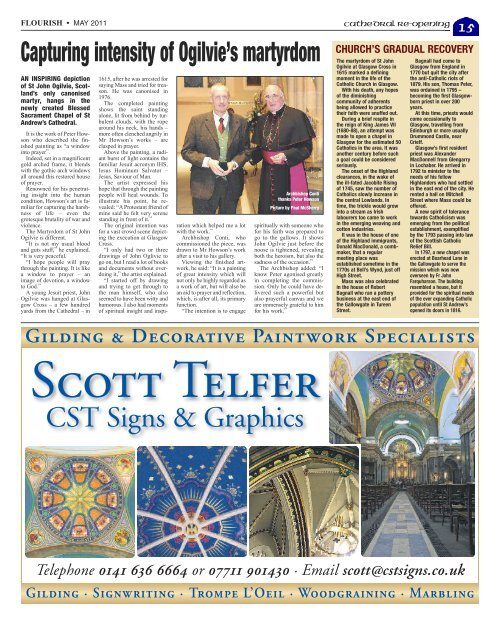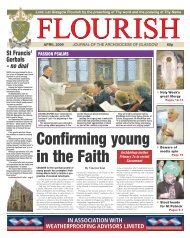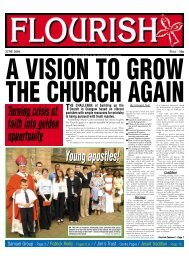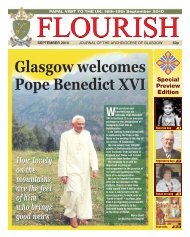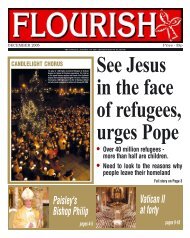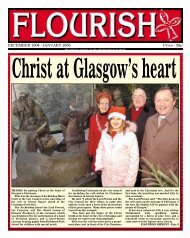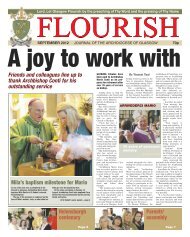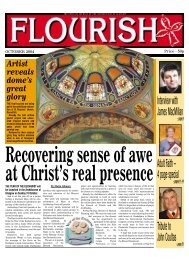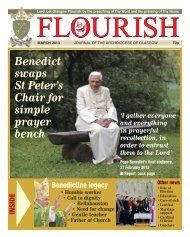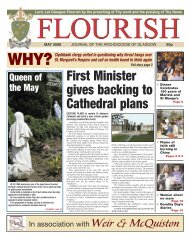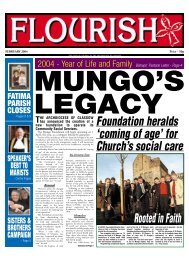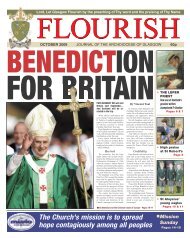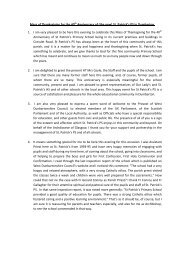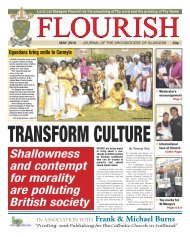May 2011 - Archdiocese of Glasgow
May 2011 - Archdiocese of Glasgow
May 2011 - Archdiocese of Glasgow
You also want an ePaper? Increase the reach of your titles
YUMPU automatically turns print PDFs into web optimized ePapers that Google loves.
FLOURISH • MAY <strong>2011</strong> CATHEDRAL RE-OPENING<br />
15<br />
Capturing intensity <strong>of</strong> Ogilvie’s martyrdom<br />
AN INSPIRING depiction<br />
<strong>of</strong> St John Ogilvie, Scotland’s<br />
only canonised<br />
martyr, hangs in the<br />
newly created Blessed<br />
Sacrament Chapel <strong>of</strong> St<br />
Andrew’s Cathedral.<br />
It is the work <strong>of</strong> Peter Howson<br />
who described the finished<br />
painting as “a window<br />
into prayer”.<br />
Indeed, set in a magnificent<br />
gold arched frame, it blends<br />
with the gothic arch windows<br />
all around this restored house<br />
<strong>of</strong> prayer.<br />
Renowned for his penetrating<br />
insight into the human<br />
condition, Howson’s art is familiar<br />
for capturing the harshness<br />
<strong>of</strong> life – even the<br />
grotesque brutality <strong>of</strong> war and<br />
violence.<br />
The Martyrdom <strong>of</strong> St John<br />
Ogilvie is different.<br />
“It is not my usual blood<br />
and guts stuff,” he explained.<br />
“It is very peaceful.<br />
“I hope people will pray<br />
through the painting. It is like<br />
a window to prayer – an<br />
image <strong>of</strong> devotion, a window<br />
to God.”<br />
A young Jesuit priest, John<br />
Ogilvie was hanged at <strong>Glasgow</strong><br />
Cross – a few hundred<br />
yards from the Cathedral – in<br />
1615, after he was arrested for<br />
saying Mass and tried for treason.<br />
He was canonised in<br />
1976.<br />
The completed painting<br />
shows the saint standing<br />
alone, lit from behind by turbulent<br />
clouds, with the rope<br />
around his neck, his hands –<br />
more <strong>of</strong>ten clenched angrily in<br />
Mr Howson’s works – are<br />
clasped in prayer.<br />
Above the painting, a radiant<br />
burst <strong>of</strong> light contains the<br />
familiar Jesuit acronym IHS,<br />
Iesus Hominum Salvator –<br />
Jesus, Saviour <strong>of</strong> Man.<br />
The artist expressed his<br />
hope that through the painting<br />
people will heal wounds. To<br />
illustrate his point, he revealed:<br />
“A Protestant friend <strong>of</strong><br />
mine said he felt very serene<br />
standing in front <strong>of</strong> it.”<br />
The original intention was<br />
for a vast crowd scene depicting<br />
the execution at <strong>Glasgow</strong><br />
Cross.<br />
“I only had two or three<br />
drawings <strong>of</strong> John Oglivie to<br />
go on, but I read a lot <strong>of</strong> books<br />
and documents without overdoing<br />
it,” the artist explained.<br />
“I started <strong>of</strong>f by drawing<br />
and trying to get through to<br />
the man himself, who also<br />
seemed to have been witty and<br />
humorous. I also had moments<br />
<strong>of</strong> spiritual insight and inspiration<br />
which helped me a lot<br />
with the work.”<br />
Archbishop Conti, who<br />
commissioned the piece, was<br />
drawn to Mr Howson’s work<br />
after a visit to his gallery.<br />
Viewing the finished artwork,<br />
he said: “It is a painting<br />
<strong>of</strong> great intensity which will<br />
not only be highly regarded as<br />
a work <strong>of</strong> art, but will also be<br />
an aid to prayer and reflection,<br />
which, is after all, its primary<br />
function.<br />
“The intention is to engage<br />
Archbishop Conti<br />
thanks Peter Howson<br />
Picture by Paul McSherry<br />
spiritually with someone who<br />
for his faith was prepared to<br />
go to the gallows. It shows<br />
John Ogilvie just before the<br />
noose is tightened, revealing<br />
both the heroism, but also the<br />
sadness <strong>of</strong> the occasion.”<br />
The Archbishop added: “I<br />
know Peter agonised greatly<br />
in completing the commission.<br />
Only he could have delivered<br />
such a powerful but<br />
also prayerful canvas and we<br />
are immensely grateful to him<br />
for his work.”<br />
CHURCH’S GRADUAL RECOVERY<br />
The martyrdom <strong>of</strong> St John<br />
Ogilvie at <strong>Glasgow</strong> Cross in<br />
1615 marked a defining<br />
moment in the life <strong>of</strong> the<br />
Catholic Church in <strong>Glasgow</strong>.<br />
With his death, any hopes<br />
<strong>of</strong> the diminishing<br />
community <strong>of</strong> adherents<br />
being allowed to practice<br />
their faith were snuffed out.<br />
During a brief respite in<br />
the reign <strong>of</strong> King James VII<br />
(1680-88), an attempt was<br />
made to open a chapel in<br />
<strong>Glasgow</strong> for the estimated 50<br />
Catholics in the area. It was<br />
another century before such<br />
a goal could be considered<br />
seriously.<br />
The onset <strong>of</strong> the Highland<br />
clearances, in the wake <strong>of</strong><br />
the ill-fated Jacobite Rising<br />
<strong>of</strong> 1745, saw the number <strong>of</strong><br />
Catholics slowly increase in<br />
the central Lowlands. In<br />
time, the trickle would grow<br />
into a stream as Irish<br />
labourers too came to work<br />
in the emerging weaving and<br />
cotton industries.<br />
It was in the house <strong>of</strong> one<br />
<strong>of</strong> the Highland immigrants,<br />
Donald MacDonald, a combmaker,<br />
that a regular<br />
meeting place was<br />
established sometime in the<br />
1770s at Bell’s Wynd, just <strong>of</strong>f<br />
High Street.<br />
Mass was also celebrated<br />
in the house <strong>of</strong> Robert<br />
Bagnall who ran a pottery<br />
business at the east end <strong>of</strong><br />
the Gallowgate in Tureen<br />
Street.<br />
Bagnall had come to<br />
<strong>Glasgow</strong> from England in<br />
1770 but quit the city after<br />
the anti-Catholic riots <strong>of</strong><br />
1879. His son, Thomas Peter,<br />
was ordained in 1795 –<br />
becoming the first <strong>Glasgow</strong>born<br />
priest in over 200<br />
years.<br />
At this time, priests would<br />
come occasionally to<br />
<strong>Glasgow</strong>, travelling from<br />
Edinburgh or more usually<br />
Drummond Castle, near<br />
Crieff.<br />
<strong>Glasgow</strong>’s first resident<br />
priest was Alexander<br />
MacDonnell from Glengarry<br />
in Lochaber. He arrived in<br />
1792 to minister to the<br />
needs <strong>of</strong> his fellow<br />
Highlanders who had settled<br />
in the east end <strong>of</strong> the city. He<br />
rented a hall on Mitchell<br />
Street where Mass could be<br />
<strong>of</strong>fered.<br />
A new spirit <strong>of</strong> tolerance<br />
towards Catholicism was<br />
emerging from the political<br />
establishment, exemplified<br />
by the 1793 passing into law<br />
<strong>of</strong> the Scottish Catholic<br />
Relief Bill.<br />
In 1797, a new chapel was<br />
erected at Boarhead Lane in<br />
the Gallowgate to serve the<br />
mission which was now<br />
overseen by Fr John<br />
Farquharson. The building<br />
resembled a house, but it<br />
provided for the spiritual needs<br />
<strong>of</strong> the ever expanding Catholic<br />
population until St Andrew’s<br />
opened its doors in 1816.<br />
Gilding & Decorative Paintwork Specialists<br />
Scott Telfer<br />
CST Signs & Graphics<br />
Telephone 0141 636 6664 or 07711 901430 · Email scott@cstsigns.co.uk<br />
Gilding · Signwriting · Trompe L’Oeil · Woodgraining · Marbling


